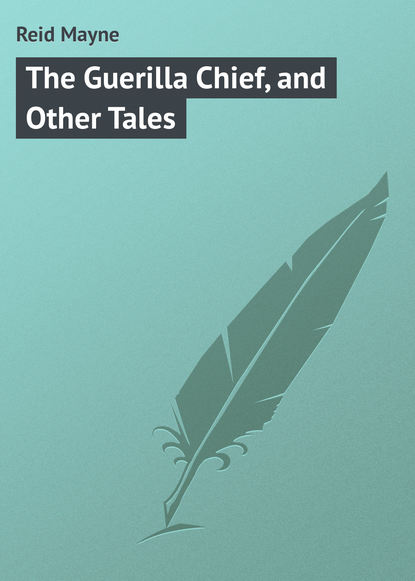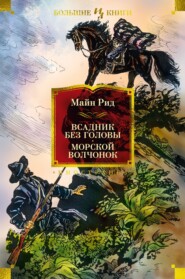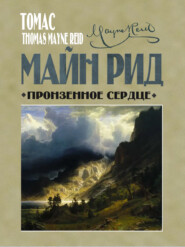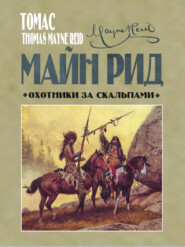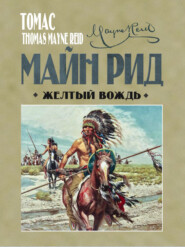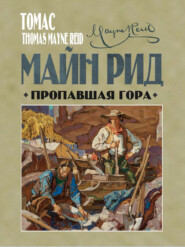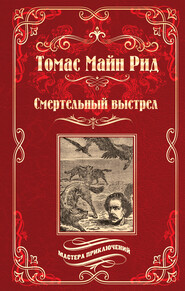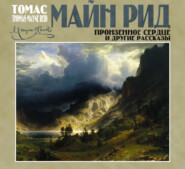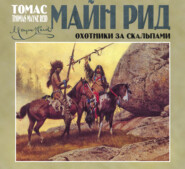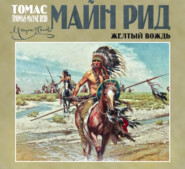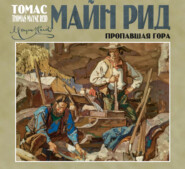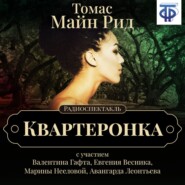По всем вопросам обращайтесь на: info@litportal.ru
(©) 2003-2024.
✖
The Guerilla Chief, and Other Tales
Настройки чтения
Размер шрифта
Высота строк
Поля
“I shed a felt dreadful at failin’ arter bein’ so cock sure o’ suckcess; but jess then I bethut me o’ another plan for reachin’ that preecious flooid. I’ve tolt ye ’bout my cuttin’ a lot o’ cane to make me a shake-down for sleepin’ on. Thar it still war, right under me – a hul cord o’ it.
“The sight o’ the long tubes surgested a new idee, which I warn’t long in puttin’ to practice. Takin’ the shirt out o’ its loop, I made the string fast to the heft o’ my bowie. I then shot the knife down among the cane, sendin’ it wi’ all my might, an’ takin’ care to keep the peint o’ the blade down’ards. It warn’t long afore I hed spiked up as much o’ thet ere cane as wud a streetched twenty yurds into the river.
“It tuk more time to manafacter the machine I intended makin’, which war a long tube as mout enable me to draw up the water o’ the stream. Thar war no eend o’ whittlin’ an’ punchin’ out the jeints, an’ then splicin’ the tubes one to the tother. But I knowd it war a case o’ life or death; an’ knowin’ thet, I worked on constant as a ole gin-hoss.
“I war rewarded for my patience. I got my blow-gun completed, an’ shovin’ it carefully out, takin’ the percaushun to gie it a double rest upon the branches, I hed the saterfaction to see its peint dippin’ down into the river.
“My mouth war applied to the other eend, an’ oh, golly! Thar warn’t no mint julep ever sucked through a straw, as tasted like the flooid that kim gurglin’ up through that ere cane. I thort I ked niver take the thing from my lips, an’ I feel putty sartin thet while I war drinkin’, the Massissippi must a fell a kupple o’ feet in the clur.”
“Ha! ha! ha!”
“Ye may larf, young fellar, an’ I’m glad to see ye in sech good spirits; but ye ant so elevated as I war. When I tuk my mouth from the cane, I feeled all over a new man, jess as ef I hed been raised from the dead, or dragged out o’ a consoomin’ fire.
“Wal, strenger, I haint yet got to the eend o’ my story – I s’pose you wish to hear the hul on it?”
“By all means – let me hear the finale.”
“I don’t know what ye mean by the finalley, but I’ll gie ye the wind-up o’ the affair; which preehaps are the most kewrious part o’ it.
“I lived in the fork of thet ere cyprus for six long days, occasionally payin’ a visit to the eagles’ necst, an’ robbin’ the young baldies o’ the food thar parents hed purvided for them. Thar diet war various, consistin’ o’ fish, flesh, an’ fowl, an’ o’ a konsequence so war mine. I hed all three for a change; sometimes a rabbit, sometimes a squrrel, with game to foller, sech as partridge, teal, an’ widgeon. I didn’t cook ’em at all. I war afraid o’ settin’ fire to the withered leaves o’ the tree, an’ burnin’ up the neest – which wud a been like killin’ the goose as laid the eggs o’ gold.
“I mout a managed that sort o’ existence for a longer spell, tho’ I acknowledge it war tiresome enuf. But it warn’t that as made me anxious to gie up, but suthin’ very diff’rent. I seed that the young baldies war every day gettin’ bigger. Thar feathers war comin’ out all over an’ I ked tell that it wudn’t be long till they’d take wing.
“When that time arrove whar shed I be? Still in the tree ov coorse; but whar war my purvision to cum from? Who wud supply me wi’ fish an’ flesh an’ fowl, as the eagles had done? Clurly ne’er a one. It war this thort as made me uneezy. I knew it war not likely I shed ever be diskivered now, since my ole ’ooman hedn’t made her appearance sooner; an’ as to any boat stoppin’ for my hail, thet trick I hed tried till I war a’most broken-winded – leastwise I hed kep’ hollerin’ every hour day arter day till my thrapple war as sore as a blister.
“I seed clarly thet I must do suthin’ to get down out o’ that tree, or die among its branches, an’ I spent all my spare time in thinkin’ what mout be did. I used to read in Webster’s spellin’-book that ‘needcessity are the mother o’ invenshun.’ I reckon old Web warn’t fur astray when he prented them ere words – anyways it proved true in the case o’ Zeb Stump, at the time he war stuck up in that cyprus.
“I hed noticed thet the two ole eagles bekim tamer and tamer as they got used to me. They seed thet I did no harm to thar chicks, ’ceptin’ so far as to abstrack from them a portion o’ thar daily allowance; but I allers took care to leave them sufficient for themselves, an’ as thar parents appeared to hev no diffeequlty in purvidin’ them wi’ plenty – unlike many parents in your country, as I’ve heerd, strenger – my pilferins didn’t seem much to distress them.
“They grew at last thet they’d sit on the one side o’ the neest, while I war peepin’ over the other!
“I seed thet I ked easily snare them, an’ I made up my mind to do thet very thing: for a purtickler purpus thet kumm’d into my head, an’ which promised to extercate me out o’ the ugly scrape I hed so foolishly got into.
“Wal, strenger, my idee war this. I hed noticed thet the eagles war both big birds, an’ strong i’ the wing. Everybody knows thet much. It thurfore occurred to me that I mout make them wings do me a sarvice, – otherways thet they mout carry me out o’ the tree.
“In coorse I didn’t intend they shed take me up i’ the air. There warn’t much danger o’ that. I only thort they mout sarve to break my fall like one o’ them things, parryshoots I b’lieve they call ’em, an’ the which I myself had seed onest in Noo Orleans, sent up into the air wi’ a cat and a coon in it.
“Arter I’d got my plan tol’ably well traced out, I sot about trappin’ the old eagles.
“In less ’n an hour’s time I hed both o’ ’em in my keepin’, wi’ thar beaks spliced to keep ’em from bitin’ me, an’ thar claws cropped clur off wi’ my bowie.
“I then strengthened the cord I hed used to draw up the canes, by doublin’ it half a dozen times, until it war stout enuf to carry my weight. One eend o’ it I looped round the legs o’ the eagles, gatherin’ all four into a bunch, whilst the other eend I made fast around my own karkiss, jess under the armpits.
“I did all this upon the lowest limb o’ the cyprus, whar I had fetched down the eagles.
“When all war ready, I drew my bowie from its sheath, and with its sharp peint I pricked both the baldies at the same time, so as to set them a-floppin. As soon as I seed thar four wings in full play, I slid off o’ the branch, directin’ myself torst the groun’ underneath.
“I ant very sartin as to what follered. I only recollex bein’ dragged through the branches o’ the cyprus, an’ the minnit arter plungin’ cochuck into the waters o’ the Massissippi. I shed most sartinly a been drowned ef that ere cord had broken, or the eagles had got loose. As it war, the birds kep’ beatin’ the water wi’ thar big wings, and in thet way hindered Zeb Stump from goin’ under.
“I’ve heerd o’ a woman they called Veenis bein’ drawed through the sea by a kupple o’ swans; but I don’t b’lieve they kud a drawed her at a quicker rate o’ speed than I war carried over the buzum o’ the Massissippi. In less than five minnits from the time I hed dropped out o’ the tree, I seed myself in the middle o’ the river and still scufflin’ on. I seed that the baldies war boun’ for the Arkansaw shore, an’ knowin’ that my life depended on thar reachin’ it, I offered no opposition to thar efforts, but lay still an’ allowed them to continue thar career.
“As good luck wud hev it, they had strength enuf left to complete the crossin’; an’ thar war another bit o’ good luck in the Arkansaw bank bein’ on a level wi’ the surface o’ the water; so that in five minnits arter, I foun’ myself among the bushes, the baldies still flutterin’ about me, as ef determined to carry me on over the great parairas o’ the West.
“I feeled that it war time to stop the steam, an’ take in sail; so clutchin’ holt o’ a branch, I brought the baldies to anchor. I war all out o’ breath, and it war some time afore I ked rekiver my legs, and release myself from my feathered kumpanyuns. I tuk good care not to let them go; though sartintly I owed them thet much for the sarvice they had done me, but jess then I bethort me o’ the Britisher at Grand Gulf – ah! you it war, ye say, young feller?”
“Certainly. And those are the eagles I purchased from Mrs Stump?”
“Them same birds, strenger. You shed a hed the young ’uns, but thar warn’t no chance ever ag’in to clomb thet cyprus, an’ what bekim o’ the poor critters arterward, I haint the most distant idee. I reckin they ended thar days in the neest, which ye still see up thar; an’ ef they did, I reckin the buzzarts wudn’t be long in makin’ a meal o’ ’em.”
With my eyes directed to the top of the tall cypress, and fixed upon a dark mass, resembling a stack of faggots, I listened to the concluding words of this queer chapter of “Backwoods Adventure.”
Story 7
The Black Jaguar – An Adventure on the Amazon
It has been a contested point among naturalists, whether the black jaguar of America is merely a variety of the felis onca, or a distinct species. The best informed writers regard it in the former light; and, so far as my observation has extended, I can perceive no essential difference between the two varieties, either in size, shape, or habits. They appear to be distinguished by colour alone.
Every one knows the colour of the common jaguar – a glossy yellowish ground, turning paler, almost whitish, under the belly and throat, and mottled all over by what appear to be jet black spots, but which, on closer inspection, turn out to be irregular rings, each with a black blotch in the centre, forming a species of marking which may very properly be termed a rosette. It is this central spot of the ring that chiefly distinguishes the markings of the jaguar from those of the leopard and panther of the Old World – these having the ring, but not the dab in the centre.
Among the felidae, of the second class, as regards size – that is, those next in size to the lion and tiger – there are five spotted species, quite distinct from one another, although they are usually spoken of under the common appellation of panthers or leopards. Four of these belong to the Old World – the true leopard, panther, the cheetah, or hunting leopard, and the ounce. The first two are very much alike, and can be distinguished from one another only by the skilled zoologist. The leopard is an inhabitant of the warmer countries of both Asia and Africa, while, as far as I can ascertain, the panther is found only in Southern Asia and the great Indian islands. The cheetah, easily identified by its shape as well as markings, its black spots being without the rings, is distributed over a vast range, comprising the whole continent of Africa, with a large portion of that of Asia.
The fourth of the great spotted cats of the Old World is the least known. Buffon procured a single skin, and gave to the animal the appellation of the “ounce;” but his description is worthless, and his knowledge is confined to the expression of a belief that it came from some eastern country – perhaps Persia. Since the time of the French naturalist the “ounce” has been a mystery; and although stuffed skins may be seen in many museums, no one appears to know whence they have been procured, or anything of the habits of the animal from which they have been stripped. But this uncertainty need continue no longer. Beyond doubt, the ounce of Buffon is the white leopard of the Himalayas, of late years often met with by Anglo-Indian hunters amongst the highest summits of those mountains, and rarely descending far below the line of the snow.
The jaguar, though often confounded with the leopard and panther of the Old World, is an entirely distinct animal, exclusively confined to America, and found there only in countries of a tropical or sub-tropical character. It is in the hottest tropical regions where this creature attains to its greatest perfection, in the size and strength if its body, and the fierceness of its disposition.
Buffon, who had a keen antipathy to everything American, describes the jaguar as an innocuous creature of inferior dimensions; but indeed this writer, whom the French love to designate as “a great naturalist,” was little else than a verbose compiler, and his knowledge of natural history would scarcely exceed that of many a schoolboy of the present day.
Humboldt more correctly characterises the jaguars, when he states that he has seen specimens which, in point of size, equal the royal tiger of India; and another distinguished naturalist, Von Tschudi, has given the measurements of one, made by himself on the spot where it was killed, in one of the Peruvian valleys, and which goes far towards confirming the statements of the great scientific traveller.
I have never myself met with a specimen of the jaguar equalling the tiger of India in size, but more than one have I seen as large as the tigress; and I believe the true state of the case to be this: – The largest jaguars are about equal in size to the smallest tigers.
As regards fierceness of disposition, and the danger to be apprehended from an encounter with them, they are indeed the rivals of either the tiger or lion of the Old World; and the disbelief in this, often expressed by flippant writers who have never set foot in a South American forest, is simply an impertinent absurdity. Hundreds of human beings dwelling upon the banks of the Amazon, the Oronoco, the Magdalena, and other large tropical rivers, have fallen victims to the savage instincts of these carnivorous creatures; and, in the eastern Andes of Peru, it is well known that more than one village has been abandoned by its inhabitants, for no other reason than to avoid the danger of being devoured by the jaguars, which like the tigers of India, instead of diminishing in numbers, usually increase by the proximity of a settlement.
It is probable that there are several varieties of the jaguar, perhaps species, distinct from one another, as the leopards of the Old World are from the panthers.
But the black jaguar does not appear anything more than an accidental circumstance in the colouring, just as the “black panther of Java” – also found in Bengal – is but a darker variety of the panther itself.
And yet, taking the testimony of the native inhabitants of South America – Indians, Portuguese, and Spaniards – there would seem to exist something more than a mere accidental difference. All agree in stating that the black jaguar is fiercer, larger, and more powerful than the fulvous kind.
Perhaps fancy may have something to do in the formation of this opinion. The former is not only far less numerous than the latter, but in most parts it is a scarce and rarely seen animal. Its habits, therefore, have been less observed. Fancy ever delights to attribute rare and wonderful qualities to that which is but little known. This may account for the peculiarities described as belonging to the black jaguar.
The nomenclature of the natives shows that, notwithstanding the difference of colour, they in reality regard these animals as being of one and the same species. “Tiger” and “black tiger,” are their respective appellations in Spanish America, while the Indians of the Lower Andes know both as the “chinca,” but distinguish them by the terms “yana chinca,” and “chaque chinca,” that is black and spotted “chincas.” Also in the “Lingoa Geral” they are respectively termed “jauarite” and “jauarite pixuna.” This marking of the relationship between two animals by the natives of a country where these animals are found, is pretty generally a safe guide to the naturalist; more particularly in a country of savage hunters, whose whole lives are spent in the pursuit and consequent observation of these creatures.
We may assume, therefore, that the black jaguar is no more than an accidental variety of the species. In fact, if you suppose the yellow or ground colour of the spotted kind to be deepened to a maroon brown, you will have the black jaguar itself; for the latter is not black, as its name would imply, but of a dark chocolate colour. The ocellae or rosettes are thickly studded over its body just as upon the fulvous kinds, and these marks, although not visible to the superficial observer, can easily be distinguished when the animal stands in a certain light.
An incident which occurred to me some years ago, in which a black jaguar played a prominent part, proved that this creature, whether or not it be different in species from its yellow congeners, is at least their equal in boldness and ferocity of disposition.
I had gone up the Amazon to the Brazilian settlement of Barra, at the mouth of the Rio Negro; and having accomplished the mission of my visit to that curious locality, I was desirous of returning again to Gran Para. There was no way of getting back but by taking passage on one of the trading vessels of the river; and on one of those which chanced to be going down to Para, I embarked.





